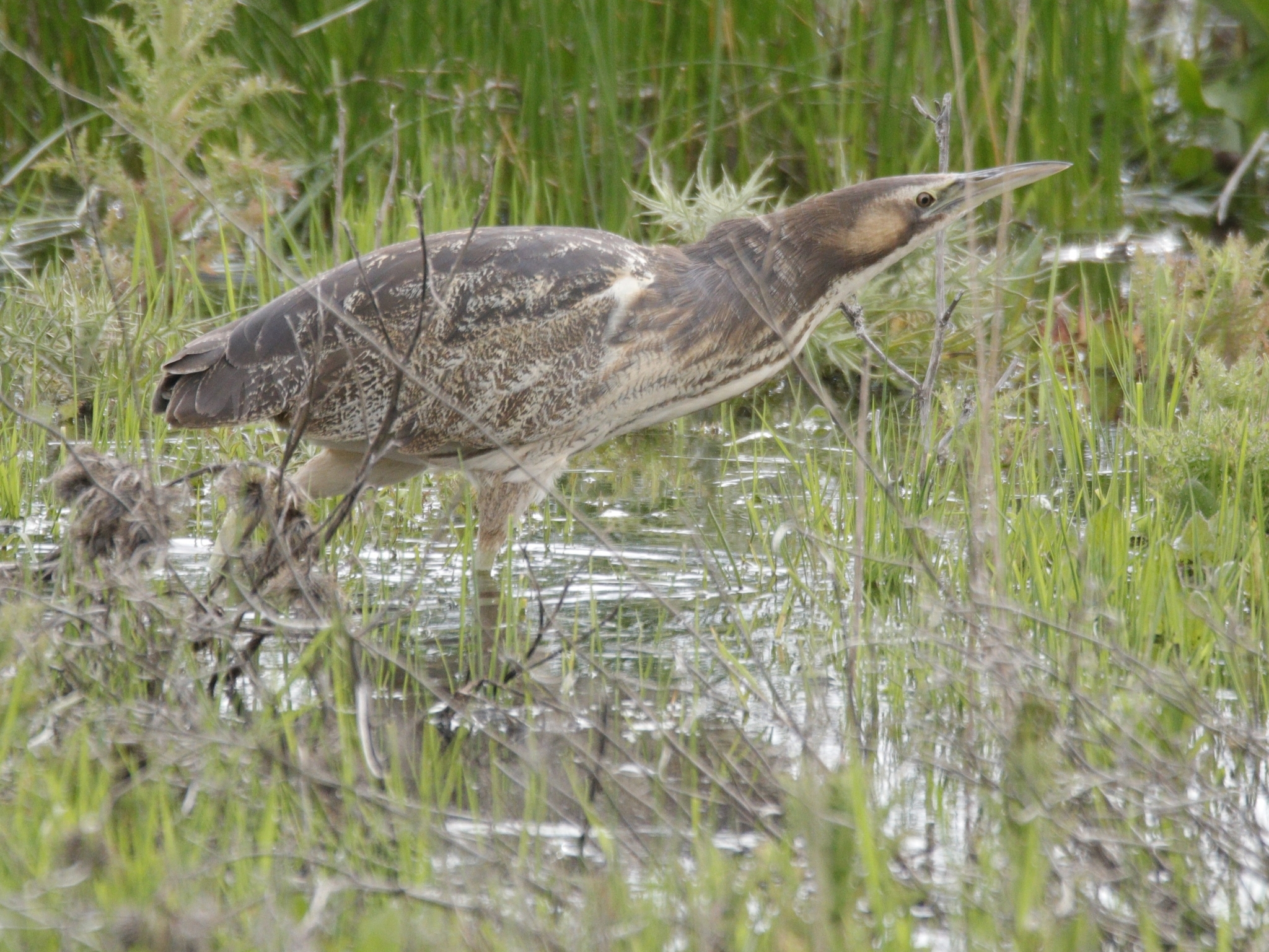Elected representatives in government are in charge of the policy and funding that can make or break saving threatened species. Their decisions and actions matter.
Maranoa has or used to have 59 threatened animals within its boundaries. One of them is me, the Australasian Bittern.
We took care to attach appropriate images that are as close to representative of each species as our resources and the availability of images allowed. However, we could not ensure perfect accuracy in every case. Some images show species that share the same genus but not at the species or subspecies level.
Australasian Bittern
Botaurus poiciloptilus
Status: Endangered
The Environment Protection and Biodiversity Conservation Act 1999 (EPBC Act) lists threatened species under six categories:
Extinct, Extinct in the wild, Critically Endangered, Endangered, Vulnerable, Conservation dependent. Read more about these categories
Botaurus poiciloptilus is found across 145 electorates.
The Australasian bittern is a secretive, stocky, heron-like bird, living in wetlands where it forages. Bitterns are very well camouflaged and can be difficult to spot in the reeds and rushes. On occasion they will even sway in time with reeds to blend into their surroundings. The distinctive booming call of males gives them away.¹
Explore more about this species on the Atlas of Living Australia





Explore more about the threats facing species on our Resources page.
- Acacia ammophila (Acacia ammophila)
- Pink Gidgee (Acacia crombiei)
- Curly-bark Wattle (Acacia curranii)
- Acacia deuteroneura (Acacia deuteroneura)
- Acacia grandifolia (Acacia grandifolia)
- Hando's Wattle (Acacia handonis)
- Tara Wattle (Acacia lauta)
- McNutt's Wattle (Acacia macnuttiana)
- Waddy (Acacia peuce)
- Birds Nest Wattle (Acacia pickardii)
- Velvet Wattle (Acacia pubifolia)
- Rupp's Wattle (Acacia ruppii)
- Torrington Pea (Almaleea cambagei)
- Androcalva procumbens (Androcalva procumbens)
- Hairy-joint Grass (Arthraxon hispidus)
- Astrotricha roddii (Astrotricha roddii)
- a shrub (Bertya calycina)
- Bertya opponens (Bertya opponens)
- Granite Boronia (Boronia granitica)
- Repand Boronia (Boronia repanda)
- Three-leaved Bosistoa (Bosistoa transversa)
- Satin-top Grass (Bothriochloa bunyensis)
- Miniature Moss-orchid (Bulbophyllum globuliforme)
- Ooline (Cadellia pentastylis)
- Black-clubbed Spider-orchid (Caladenia atroclavia)
- Callistemon pungens (Callistemon pungens)
- Calytrix gurulmundensis (Calytrix gurulmundensis)
- Stream Clematis (Clematis fawcettii)
- Cossinia (Cossinia australiana)
- Leafless Tongue-orchid (Cryptostylis hunteriana)
- Daviesia discolor (Daviesia discolor)
- Small-leaved Denhamia (Denhamia parvifolia)
- King Blue-grass (Dichanthium queenslandicum)
- Bluegrass (Dichanthium setosum)
- Small Snake Orchid (Diuris pedunculata)
- Salt Pipewort (Eriocaulon carsonii)
- Blue Devil (Eryngium fontanum)
- Queensland White Gum (Eucalyptus argophloia)
- Ovenden's Ironbark (Eucalyptus caleyi subsp. ovendenii)
- Slaty Red Gum (Eucalyptus glaucina)
- Durikai Mallee (Eucalyptus infera)
- McKie's Stringybark (Eucalyptus mckieana)
- Narrow-leaved Peppermint (Eucalyptus nicholii)
- Wallangarra White Gum (Eucalyptus scoparia)
- Eucalyptus virens (Eucalyptus virens)
- Frankenia plicata (Frankenia plicata)
- Flame Spider-flower (Grevillea kennedyana)
- Grevillea quadricauda (Grevillea quadricauda)
- Black Grevillea (Grevillea scortechinii subsp. scortechinii)
- Hakea maconochieana (Hakea maconochieana)
- Tall Velvet Sea-berry (Haloragis exalata subsp. velutina)
- Belson's Panic (Homopholis belsonii)
- a shrub (Homoranthus decumbens)
- Homoranthus lunatus (Homoranthus lunatus)
- Homoranthus montanus (Homoranthus montanus)
- a shrub (Kardomia granitica)
- Proston Lasiopetalum (Lasiopetalum sp. Proston )
- Leionema obtusifolium (Leionema obtusifolium)
- Winged Pepper-cress (Lepidium monoplocoides)
- Wandering Pepper-cress (Lepidium peregrinum)
- Torrington Beard-heath (Leucopogon confertus)
- Leucopogon sp. Coolmunda (Leucopogon sp. Coolmunda )
- Macadamia Nut (Macadamia integrifolia)
- Macrozamia conferta (Macrozamia conferta)
- Macrozamia cranei (Macrozamia cranei)
- Macrozamia machinii (Macrozamia machinii)
- Macrozamia occidua (Macrozamia occidua)
- Chariot Wheels (Maireana cheelii)
- Marsdenia brevifolia (Marsdenia brevifolia)
- Clear Milkvine (Marsdenia longiloba)
- Melaleuca kunzeoides (Melaleuca kunzeoides)
- Microcarpaea agonis (Microcarpaea agonis)
- a grass (Paspalidium grandispiculatum)
- Knotweed (Persicaria elatior)
- Mt Berryman Phebalium (Phebalium distans)
- Rusty Desert Phebalium (Phebalium glandulosum subsp. eglandulosum)
- Phebalium whitei (Phebalium whitei)
- Hawkweed (Picris evae)
- Polianthion minutiflorum (Polianthion minutiflorum)
- Prostanthera sp. Dunmore (Prostanthera sp. Dunmore )
- Rhaphidospora bonneyana (Rhaphidospora bonneyana)
- Austral Cornflower (Rhaponticum australe)
- Scrub Turpentine (Rhodamnia rubescens)
- Native Guava (Rhodomyrtus psidioides)
- Waxy Sarcochilus (Sarcochilus hartmannii)
- Blotched Sarcochilus (Sarcochilus weinthalii)
- Sclerolaena blakei (Sclerolaena blakei)
- Sclerolaena walkeri (Sclerolaena walkeri)
- Sophora fraseri (Sophora fraseri)
- a grass (Sporobolus pamelae)
- Slender Darling-pea (Swainsona murrayana)
- Austral Toadflax (Thesium australe)
- Tylophora linearis (Tylophora linearis)
- Tylophora woollsii (Tylophora woollsii)
- Westringia parvifolia (Westringia parvifolia)
- Xerothamnella herbacea (Xerothamnella herbacea)
- Xerothamnella parvifolia (Xerothamnella parvifolia)
- Zieria verrucosa (Zieria verrucosa)
You are in federal electorate Maranoa.
